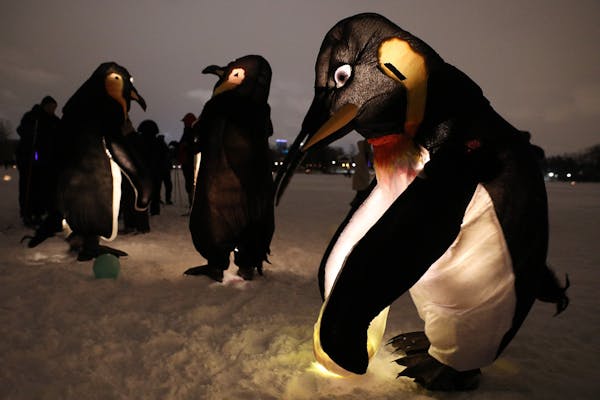One of the two Arrowhead 135 ultramarathoners recovering after a successful double Arrowhead attempt said the first 135 miles on foot to get to the start prepared them to do the second 135 miles.
Held in late January and often in bitter cold, the Arrowhead 135 race is regarded as one of the most-extreme endurance events in the world. The race runs along the rugged Arrowhead Trail from International Falls to Tower in northern Minnesota. Arrowhead entrants compete by bike, by ski, or on foot.
Kari Gibbons and Kate Coward, both of Minneapolis, successfully completed a "Double Arrowhead" last week – the first women to do so – when they raced on foot, sleds loaded with gear, from Tower to International Falls, and turned it around to officially race back Jan. 29 to Tower. They finished late afternoon Jan. 31. All told they were on the trail seven consecutive days. (Above, Coward is left and Gibbons right.)
Gibbons said in an e-mail Sunday that doing the first 135 miles with Coward prepared them for the push back to Tower, and they had their system "dialed in" by race start.
"Acclimating to being on the trail really benefited us in the long run," Gibbons said. "I believe it also helped us on that deep freeze. We were so used to being on the trail it was just a matter of putting on more clothing and not stopping for anything!"
Coward and Gibbons, both 38, said it was hard to single out one day as the toughest amid the challenges of staying warm, moving forward, staying fueled, and fighting fatigue and sleep deprivation.
Still, for Coward, the final day Jan. 31 was intense. Coward said the two ended up sleeping about 13 hours over the seven days, trying to get to checkpoints of the race on time. Night temperatures Jan. 29 hit 29-below, she said.
"You couple that with the mental challenge of being so close to the end, which just makes things take longer," Coward said. "It's so important to be patient, but when your feet are aching and sending sharp shooting pains, and you are so sleep-deprived that you are stumbled around the trail, and you are sick of eating all your food, and it's too hard to get your water because of the wind -- it all adds up."
Gibbons said that she is recovering with a lot of napping, but also dreams of being on the Arrowhead. "The mental side of these events, even without the Double, runs deep," she said.
Coward said she is recovering with some good meals and "a lot of yoga" for sore muscles – and thinking about what's next.
Both women emphasized that teamwork made the difference. Volunteers, family and other athletes supported them in simple but important ways. Sometimes it came in the form of nourishment, sometimes in words of encouragement.
"You hear many stories like this of one moment, or person, who completely changed the fate of the race for someone," Coward said.
Too, Coward and Gibbons knew they couldn't have succeeded without the other by her side.
"It is very much a team sport. Imagining doing it without Kate seems so bleak, I just can't go there. Our friends new and old on the trail were so incredibly encouraging it was a constant reminder of our goal, and to not give up. We are strong together.
"All in all, after two days of sleep, I miss it terribly and would do just about anything to be out there again," Gibbons said.
Macron takes part in charity soccer game, showing off sporting prowess
Josef Newgarden's win in IndyCar's season-opening race has been disqualified. O'Ward named winner
U football continues strong activity in transfer portal with QB addition

